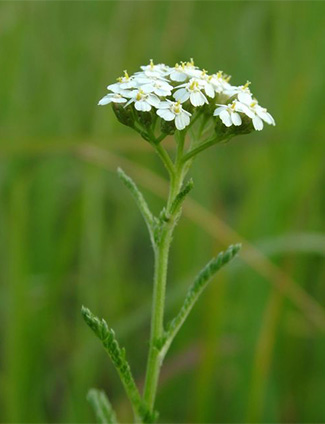Yarrow Essential Oil
Achillea millefolium

Description
Yarrow Essential Oil is dark blue in color and is similar in hue to that of German Chamomile Essential Oil and Blue Tansy Essential Oil due to its chamazulene content. Chamazulene is a sesquiterpene that exhibits anti-inflammatory and antispasmodic properties. It is sometimes known as Blue Yarrow Essential Oil.
Aromatically, Yarrow Essential Oil is a bit dull to me, but I don't find it to be unpleasant whatsoever. It's somewhat similar in aroma to Blue Tansy Essential Oil, but it's not as aromatically sweet. Yarrow Essential Oil blends well aromatically with most other essential oils.
Emotionally, I find Yarrow Essential Oil to be a helpful oil to work with when doing introspection and self study. Working quietly with Yarrow Oil can encourage me to take an objective look within without fear of what I may discover about myself. I've found yarrow to be a beautiful essential oil to work with for this purpose, and I also love including it within my personal meditation practice.
Robbi Zeck tells us that Yarrow Essential Oil helps to bring about balance and stability, and I agree based on my own personal experiences in working with yarrow. "Yarrow stabilises polar opposites within the body and is useful during times of major life changes, when emotional equilibrium needs greater support." [Robbi Zeck, ND, The Blossoming Heart: Aromatherapy for Healing and Transformation (Victoria, Australia: Aroma Tours, 2008), 121.]
Yarrow Essential Oil Benefits and Uses
- Rheumatism
- Arthritis
- Inflamed/Injured Muscles
- Muscular And Menstrual Cramps
- Scarring
- Acne
- Eczema
- Rashes
- Hemorrhoids
- Wound Care
Sources: Valerie Ann Worwood, The Complete Book of Essential Oils and Aromatherapy, 25th Anniversary Edition (Novato, CA: New World Library, 2016, 631. Neryls Purchon and Lora Cantele, Complete Aromatherapy & Essential Oils Handbook for Everyday Wellness (Toronto ON: Robert Rose, 2014), 116.
Botanical Name
Plant Family
Common Method of Extraction
Steam Distilled
Plant Part Typically Used
Color

Dark Blue
Consistency
Medium
Perfumery Note
Middle
Strength of Initial Aroma
Medium - Strong
Aromatic Description
Yarrow Essential Oil smells sharp, woody, herbaceous, fruity and somewhat sweet.
Sustainability and Conservation Status
Least Concern
Source: https://www.iucnredlist.org/species/202909/78457012
To learn more about the conservation status of essential oil bearing plants and how to use the IUCN Red List of Threatened Species, please refer to AromaWeb's Guide to Essential Oils and Sustainability.
Major Constituents of Yarrow Essential Oil
- Sabinene
- Chamazulene
- B-Myrcene
- Germacrene D
- B-Pinene
- Camphor
- Camphene
Source: Private Communication: Rondeau, 1999. Source cited in Robert Tisserand and Rodney Young, Essential Oil Safety (Second Edition. United Kingdom: Churchill Livingstone Elsevier, 2014), 475.
Yarrow Essential Oil Safety Information
Tisserand and Young caution that a drug interaction may occur if using drugs metabolized by CYP2D6. Neurotoxicity is possible. They recommend a dermal maximum of 8.6%. Reading Tisserand and Young's full profile is recommended. [Robert Tisserand and Rodney Young, Essential Oil Safety (Second Edition. United Kingdom: Churchill Livingstone Elsevier, 2014), 243.]
Yarrow CO2 Supercritical Total Extract
In addition to being available as an essential oil, this botanical is available from a small number of reputable sources as a CO2 extract. CO2 extracts offer many advantages. However, they can have differing safety precautions than essential oils because the natural chemistry of CO2 extracts can differ from their essential oil counterparts. Not much safety information is documented from trusted sources for CO2 extracts. Use CO2 extracts with great care and do not assume that every CO2 extract has the same safety precautions as its essential oil counterpart.
General Safety Information
Do not take any oils internally and do not apply undiluted essential oils, absolutes, CO2s or other concentrated essences onto the skin without advanced essential oil knowledge or consultation from a qualified aromatherapy practitioner. For general dilution information, read AromaWeb's Guide to Diluting Essential Oils. If you are pregnant, epileptic, have liver damage, have cancer, or have any other medical problem, use oils only under the proper guidance of a qualified aromatherapy practitioner. Use extreme caution when using oils with children and be sure to first read the recommended dilution ratios for children. Consult a qualified aromatherapy practitioner before using oils with children, the elderly, if you have medical issues or are taking medications. Before using this or any essential oil, carefully read AromaWeb's Essential Oil Safety Information page. For in-depth information on oil safety issues, read Essential Oil Safety by Robert Tisserand and Rodney Young.
Shelf Life
Important Information About the Profiles
The essential oil information provided on AromaWeb is intended for basic educational purposes only. The references to safety information, test results, constituents and percentages is generalized information. Essential oils can vary greatly in composition. The data is not necessary complete and is not guaranteed to be accurate. The essential oil photos are intended to represent the typical and approximate color of each essential oil. However, essential oil composition and color can vary based on harvesting, distillation, age of the essential oil and other factors. Profiles for several CO2 Extracts and absolutes are included within the directory, and are denoted as such.
